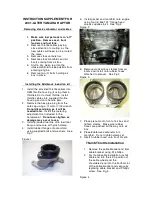
TN-18-16-001 R2
Page 1 of 15
Inspect the Model 3 and Model Y HV Battery for Underside
Damage
Tech Notes are announcements that help to communicate and track new information about Tesla Service concerns. Such
concerns may or may not be VIN specific. These instructions assume knowledge of motor vehicle and high voltage
electrical component repairs, and should only be executed by trained professionals. Tesla assumes no liability for injury or
property damage due to a failure to properly follow these instructions or for repairs attempted by unqualified individuals.
This Tech Note supersedes TN-18-16-001 R1, dated 12-Jun-20. Each content change is marked by a vertical line in the
left margin. Discard the previous version and replace it with this one.
Whenever the vehicle is raised, or if the customer has indicated possible damage, the underside of the vehicle, including
the High Voltage (HV) battery, should be visually inspected for damage. HV battery damage may include:
•
Dents, holes, cracks, or tears
•
Corrosion or moisture accumulation
•
Evidence of a previous thermal event, such as smoke residue, discoloration, deformation, melted seals, metallic
platter, or abnormal odor
•
Rupture or disassembly
•
Coolant or electrolyte leakage
NOTE:
If a vehicle is brought into a Body Shop with visible damage to the bottom of the HV battery, the Body Shop
should contact Tesla:
•
In Europe, Middle East, and Africa:
Contact
•
All other regions:
Contact your local Tesla Service Center.
The Body Shop should not try to repair the HV battery damage. Only Tesla Service Centers should try to repair the
damaged HV battery.
TN-18-16-001 R2
December 15, 2021
Tesla, Inc.
Technical Note
Model:
Vehicle System:
Region:
Model 3
Model Y
16 - Battery System
All

































